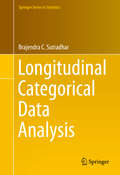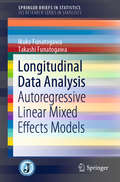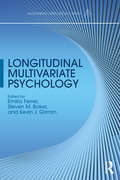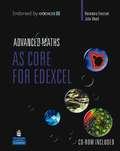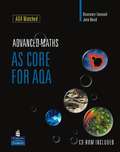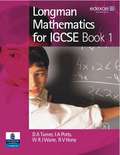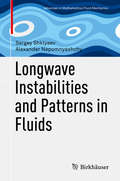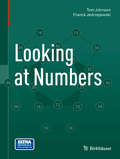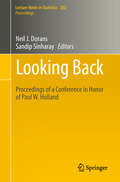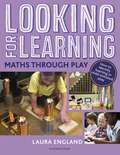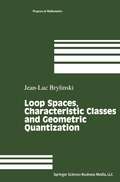- Table View
- List View
Longitudinal Categorical Data Analysis (Springer Series in Statistics)
by Brajendra C. SutradharThis is the first book in longitudinal categorical data analysis with parametric correlation models developed based on dynamic relationships among repeated categorical responses. This book is a natural generalization of the longitudinal binary data analysis to the multinomial data setup with more than two categories. Thus, unlike the existing books on cross-sectional categorical data analysis using log linear models, this book uses multinomial probability models both in cross-sectional and longitudinal setups. A theoretical foundation is provided for the analysis of univariate multinomial responses, by developing models systematically for the cases with no covariates as well as categorical covariates, both in cross-sectional and longitudinal setups. In the longitudinal setup, both stationary and non-stationary covariates are considered. These models have also been extended to the bivariate multinomial setup along with suitable covariates. For the inferences, the book uses the generalized quasi-likelihood as well as the exact likelihood approaches.The book is technically rigorous, and, it also presents illustrations of the statistical analysis of various real life data involving univariate multinomial responses both in cross-sectional and longitudinal setups. This book is written mainly for the graduate students and researchers in statistics and social sciences, among other applied statistics research areas. However, the rest of the book, specifically the chapters from 1 to 3, may also be used for a senior undergraduate course in statistics.
Longitudinal Data Analysis: Autoregressive Linear Mixed Effects Models (SpringerBriefs in Statistics)
by Ikuko Funatogawa Takashi FunatogawaThis book provides a new analytical approach for dynamic data repeatedly measured from multiple subjects over time. Random effects account for differences across subjects. Auto-regression in response itself is often used in time series analysis. In longitudinal data analysis, a static mixed effects model is changed into a dynamic one by the introduction of the auto-regression term. Response levels in this model gradually move toward an asymptote or equilibrium which depends on covariates and random effects. The book provides relationships of the autoregressive linear mixed effects models with linear mixed effects models, marginal models, transition models, nonlinear mixed effects models, growth curves, differential equations, and state space representation. State space representation with a modified Kalman filter provides log likelihoods for maximum likelihood estimation, and this representation is suitable for unequally spaced longitudinal data. The extension to multivariate longitudinal data analysis is also provided. Topics in medical fields, such as response-dependent dose modifications, response-dependent dropouts, and randomized controlled trials are discussed. The text is written in plain terms understandable for researchers in other disciplines such as econometrics, sociology, and ecology for the progress of interdisciplinary research.
Longitudinal Data Analysis (Wiley Series in Probability and Statistics #451)
by Donald Hedeker Robert D. GibbonsLongitudinal data analysis for biomedical and behavioral sciences This innovative book sets forth and describes methods for the analysis of longitudinaldata, emphasizing applications to problems in the biomedical and behavioral sciences. Reflecting the growing importance and use of longitudinal data across many areas of research, the text is designed to help users of statistics better analyze and understand this type of data. Much of the material from the book grew out of a course taught by Dr. Hedeker on longitudinal data analysis. The material is, therefore, thoroughly classroom tested and includes a number of features designed to help readers better understand and apply the material. Statistical procedures featured within the text include: * Repeated measures analysis of variance * Multivariate analysis of variance for repeated measures * Random-effects regression models (RRM) * Covariance-pattern models * Generalized-estimating equations (GEE) models * Generalizations of RRM and GEE for categorical outcomes Practical in their approach, the authors emphasize the applications of the methods, using real-world examples for illustration. Some syntax examples are provided, although the authors do not generally focus on software in this book. Several datasets and computer syntax examples are posted on this title's companion Web site. The authors intend to keep the syntax examples current as new versions of the software programs emerge. This text is designed for both undergraduate and graduate courses in longitudinal data analysis. Instructors can take advantage of overheads and additional course materials available online for adopters. Applied statisticians in biomedicine and the social sciences can also use the book as a convenient reference.
Longitudinal Data Analysis: A Practical Guide for Researchers in Aging, Health, and Social Sciences (Multivariate Applications Series)
by Jason Newsom Richard N. Jones Scott M. HoferThis book provides accessible treatment to state-of-the-art approaches to analyzing longitudinal studies. Comprehensive coverage of the most popular analysis tools allows readers to pick and choose the techniques that best fit their research. The analyses are illustrated with examples from major longitudinal data sets including practical information about their content and design. Illustrations from popular software packages offer tips on how to interpret the results. Each chapter features suggested readings for additional study and a list of articles that further illustrate how to implement the analysis and report the results. Syntax examples for several software packages for each of the chapter examples are provided at www.psypress.com/longitudinal-data-analysis. Although many of the examples address health or social science questions related to aging, readers from other disciplines will find the analyses relevant to their work. In addition to demonstrating statistical analysis of longitudinal data, the book shows how to interpret and analyze the results within the context of the research design. The methods covered in this book are applicable to a range of applied problems including short- to long-term longitudinal studies using a range of sample sizes. The book provides non-technical, practical introductions to the concepts and issues relevant to longitudinal analysis. Topics include use of publicly available data sets, weighting and adjusting for complex sampling designs with longitudinal studies, missing data and attrition, measurement issues related to longitudinal research, the use of ANOVA and regression for average change over time, mediation analysis, growth curve models, basic and advanced structural equation models, and survival analysis. An ideal supplement for graduate level courses on data analysis and/or longitudinal modeling taught in psychology, gerontology, public health, human development, family studies, medicine, sociology, social work, and other behavioral, social, and health sciences, this multidisciplinary book will also appeal to researchers in these fields.
Longitudinal Data Analysis: A Practical Guide for Researchers in Aging, Health, and Social Sciences (Multivariate Applications Series)
by Jason T. Newsom Richard N. Jones Scott M. HoferThis book provides accessible treatment to state-of-the-art approaches to analyzing longitudinal studies. Comprehensive coverage of the most popular analysis tools allows readers to pick and choose the techniques that best fit their research. The analyses are illustrated with examples from major longitudinal data sets including practical information about their content and design. Illustrations from popular software packages offer tips on how to interpret the results. Each chapter features suggested readings for additional study and a list of articles that further illustrate how to implement the analysis and report the results. Syntax examples for several software packages for each of the chapter examples are provided at www.psypress.com/longitudinal-data-analysis. Although many of the examples address health or social science questions related to aging, readers from other disciplines will find the analyses relevant to their work. In addition to demonstrating statistical analysis of longitudinal data, the book shows how to interpret and analyze the results within the context of the research design. The methods covered in this book are applicable to a range of applied problems including short- to long-term longitudinal studies using a range of sample sizes. The book provides non-technical, practical introductions to the concepts and issues relevant to longitudinal analysis. Topics include use of publicly available data sets, weighting and adjusting for complex sampling designs with longitudinal studies, missing data and attrition, measurement issues related to longitudinal research, the use of ANOVA and regression for average change over time, mediation analysis, growth curve models, basic and advanced structural equation models, and survival analysis. An ideal supplement for graduate level courses on data analysis and/or longitudinal modeling taught in psychology, gerontology, public health, human development, family studies, medicine, sociology, social work, and other behavioral, social, and health sciences, this multidisciplinary book will also appeal to researchers in these fields.
Longitudinal Data with Serial Correlation: A State-Space Approach (Chapman & Hall/CRC Monographs on Statistics and Applied Probability)
by Richard .H. JonesThis monograph is written for students at the graduate level in biostatistics, statistics or other disciplines that collect longitudinal data. It concentrates on the state space approach that provides a convenient way to compute likelihoods using the Kalman filter.
Longitudinal Data with Serial Correlation: A State-Space Approach (Chapman & Hall/CRC Monographs on Statistics and Applied Probability)
by Richard .H. JonesThis monograph is written for students at the graduate level in biostatistics, statistics or other disciplines that collect longitudinal data. It concentrates on the state space approach that provides a convenient way to compute likelihoods using the Kalman filter.
Longitudinal Multivariate Psychology (Multivariate Applications Series)
by Emilio Ferrer Steven M. Boker Kevin J. GrimmThis volume presents a collection of chapters focused on the study of multivariate change. As people develop and change, multivariate measurement of that change and analysis of those measures can illuminate the regularities in the trajectories of individual development, as well as time-dependent changes in population averages. As longitudinal data have recently become much more prevalent in psychology and the social sciences, models of change have become increasingly important. This collection focuses on methodological, statistical, and modeling aspects of multivariate change and applications of longitudinal models to the study of psychological processes. The volume is divided into three major sections: Extension of latent change models, Measurement and testing issues in longitudinal modeling, and Novel applications of multivariate longitudinal methodology. It is intended for advanced students and researchers interested in learning about state-of-the-art techniques for longitudinal data analysis, as well as understanding the history and development of such techniques.
Longitudinal Multivariate Psychology (Multivariate Applications Series)
by Emilio Ferrer Steven M. Boker Kevin J. GrimmThis volume presents a collection of chapters focused on the study of multivariate change. As people develop and change, multivariate measurement of that change and analysis of those measures can illuminate the regularities in the trajectories of individual development, as well as time-dependent changes in population averages. As longitudinal data have recently become much more prevalent in psychology and the social sciences, models of change have become increasingly important. This collection focuses on methodological, statistical, and modeling aspects of multivariate change and applications of longitudinal models to the study of psychological processes. The volume is divided into three major sections: Extension of latent change models, Measurement and testing issues in longitudinal modeling, and Novel applications of multivariate longitudinal methodology. It is intended for advanced students and researchers interested in learning about state-of-the-art techniques for longitudinal data analysis, as well as understanding the history and development of such techniques.
Longitudinal Research with Latent Variables
by Kees Van Montfort Johan H. L. Oud Albert SatorraSince Charles Spearman published his seminal paper on factor analysis in 1904 and Karl Joresk ¨ og replaced the observed variables in an econometric structural equation model by latent factors in 1970, causal modelling by means of latent variables has become the standard in the social and behavioural sciences. Indeed, the central va- ables that social and behavioural theories deal with, can hardly ever be identi?ed as observed variables. Statistical modelling has to take account of measurement - rors and invalidities in the observed variables and so address the underlying latent variables. Moreover, during the past decades it has been widely agreed on that serious causal modelling should be based on longitudinal data. It is especially in the ?eld of longitudinal research and analysis, including panel research, that progress has been made in recent years. Many comprehensive panel data sets as, for example, on human development and voting behaviour have become available for analysis. The number of publications based on longitudinal data has increased immensely. Papers with causal claims based on cross-sectional data only experience rejection just for that reason.
Longitudinal Structural Equation Modeling: A Comprehensive Introduction (Multivariate Applications Series)
by Jason T. NewsomThis comprehensive resource reviews structural equation modeling (SEM) strategies for longitudinal data to help readers see which modeling options are available for which hypotheses. The author demonstrates how SEM is related to other longitudinal data techniques throughout. By exploring connections between models, readers gain a better understanding of when to choose one analysis over another. The book explores basic models to sophisticated ones including the statistical and conceptual underpinnings that are the building blocks of the analyses.? Accessibly written, research examples from the behavioral and social sciences and results interpretations are provided throughout. The emphasis is on concepts and practical guidance for applied research rather than on mathematical proofs. New terms are highlighted and defined in the glossary. Figures are included for every model along with detailed discussions of model specification and implementation issues.? Each chapter also includes examples of each model type, comment sections that provide practical guidance, model extensions, and recommended readings. Highlights include: Covers the major SEM approaches to longitudinal analysis in one resource. Explores connections between longitudinal SEM models to enhance integration.? Numerous examples that help readers match research questions to appropriate analyses and interpret results. Reviews practical issues related to model specification and estimation to reinforce connections.? Analyzes continuous and discrete (binary and ordinal) variables throughout for breadth not found in other sources. Reviews key SEM concepts for those who need a refresher (Ch. 1).? Emphasizes how to apply and interpret each model through realistic data examples. Provides the book’s data sets at www.longitudinalsem.com along with the Mplus and R-lavaan syntax used to generate the results. Introduces the LISREL notation system used throughout (Appendix A).? The chapters can be read out of order but it is best to read chapters 1 – 4 first because most of the later chapters refer back to them. The book opens with a review of latent variables and analysis of binary and ordinal variables. Chapter 2 applies this information to assessing longitudinal measurement invariance.? SEM tests of dependent means and proportions over time points are explored in Chapter 3, and stability and change, difference scores, and lagged regression are covered in Chapter 4. The remaining chapters are each devoted to one major type of longitudinal SEM -- repeated measures analysis models, full cross-lagged panel models and simplex models, modeling stability with state-trait models, linear and nonlinear growth curve models, latent difference score models, latent transition analysis, time series analysis, survival analysis, and attrition. Missing data is discussed in the context of many of the preceding models in Chapter 13.? Ideal for graduate courses on longitudinal (data) analysis, advanced SEM, longitudinal SEM, and/or advanced data (quantitative) analysis taught in the behavioral, social, and health sciences, this text also appeals to researchers in these fields. Intended for those without an extensive math background, prerequisites include familiarity with basic SEM. Matrix algebra is avoided in all but a few places.
Longitudinal Structural Equation Modeling: A Comprehensive Introduction (Multivariate Applications Series)
by Jason T. NewsomThis comprehensive resource reviews structural equation modeling (SEM) strategies for longitudinal data to help readers see which modeling options are available for which hypotheses. The author demonstrates how SEM is related to other longitudinal data techniques throughout. By exploring connections between models, readers gain a better understanding of when to choose one analysis over another. The book explores basic models to sophisticated ones including the statistical and conceptual underpinnings that are the building blocks of the analyses.? Accessibly written, research examples from the behavioral and social sciences and results interpretations are provided throughout. The emphasis is on concepts and practical guidance for applied research rather than on mathematical proofs. New terms are highlighted and defined in the glossary. Figures are included for every model along with detailed discussions of model specification and implementation issues.? Each chapter also includes examples of each model type, comment sections that provide practical guidance, model extensions, and recommended readings. Highlights include: Covers the major SEM approaches to longitudinal analysis in one resource. Explores connections between longitudinal SEM models to enhance integration.? Numerous examples that help readers match research questions to appropriate analyses and interpret results. Reviews practical issues related to model specification and estimation to reinforce connections.? Analyzes continuous and discrete (binary and ordinal) variables throughout for breadth not found in other sources. Reviews key SEM concepts for those who need a refresher (Ch. 1).? Emphasizes how to apply and interpret each model through realistic data examples. Provides the book’s data sets at www.longitudinalsem.com along with the Mplus and R-lavaan syntax used to generate the results. Introduces the LISREL notation system used throughout (Appendix A).? The chapters can be read out of order but it is best to read chapters 1 – 4 first because most of the later chapters refer back to them. The book opens with a review of latent variables and analysis of binary and ordinal variables. Chapter 2 applies this information to assessing longitudinal measurement invariance.? SEM tests of dependent means and proportions over time points are explored in Chapter 3, and stability and change, difference scores, and lagged regression are covered in Chapter 4. The remaining chapters are each devoted to one major type of longitudinal SEM -- repeated measures analysis models, full cross-lagged panel models and simplex models, modeling stability with state-trait models, linear and nonlinear growth curve models, latent difference score models, latent transition analysis, time series analysis, survival analysis, and attrition. Missing data is discussed in the context of many of the preceding models in Chapter 13.? Ideal for graduate courses on longitudinal (data) analysis, advanced SEM, longitudinal SEM, and/or advanced data (quantitative) analysis taught in the behavioral, social, and health sciences, this text also appeals to researchers in these fields. Intended for those without an extensive math background, prerequisites include familiarity with basic SEM. Matrix algebra is avoided in all but a few places.
Longitudinal Structural Equation Modeling: A Comprehensive Introduction (Multivariate Applications Series)
by Jason T. NewsomLongitudinal Structural Equation Modeling is a comprehensive resource that reviews structural equation modeling (SEM) strategies for longitudinal data to help readers determine which modeling options are available for which hypotheses. This accessibly written book explores a range of models, from basic to sophisticated, including the statistical and conceptual underpinnings that are the building blocks of the analyses. By exploring connections between models, it demonstrates how SEM is related to other longitudinal data techniques and shows when to choose one analysis over another. Newsom emphasizes concepts and practical guidance for applied research rather than focusing on mathematical proofs, and new terms are highlighted and defined in the glossary. Figures are included for every model along with detailed discussions of model specification and implementation issues and each chapter also includes examples of each model type, descriptions of model extensions, comment sections that provide practical guidance, and recommended readings. Expanded with new and updated material, this edition includes many recent developments, a new chapter on growth mixture modeling, and new examples. Ideal for graduate courses on longitudinal (data) analysis, advanced SEM, longitudinal SEM, and/or advanced data (quantitative) analysis taught in the behavioral, social, and health sciences, this new edition will continue to appeal to researchers in these fields.
Longitudinal Structural Equation Modeling: A Comprehensive Introduction (Multivariate Applications Series)
by Jason T. NewsomLongitudinal Structural Equation Modeling is a comprehensive resource that reviews structural equation modeling (SEM) strategies for longitudinal data to help readers determine which modeling options are available for which hypotheses. This accessibly written book explores a range of models, from basic to sophisticated, including the statistical and conceptual underpinnings that are the building blocks of the analyses. By exploring connections between models, it demonstrates how SEM is related to other longitudinal data techniques and shows when to choose one analysis over another. Newsom emphasizes concepts and practical guidance for applied research rather than focusing on mathematical proofs, and new terms are highlighted and defined in the glossary. Figures are included for every model along with detailed discussions of model specification and implementation issues and each chapter also includes examples of each model type, descriptions of model extensions, comment sections that provide practical guidance, and recommended readings. Expanded with new and updated material, this edition includes many recent developments, a new chapter on growth mixture modeling, and new examples. Ideal for graduate courses on longitudinal (data) analysis, advanced SEM, longitudinal SEM, and/or advanced data (quantitative) analysis taught in the behavioral, social, and health sciences, this new edition will continue to appeal to researchers in these fields.
A Longitudinal Study of Adolescent Growth
by John M.H. BucklerA Longitudinal Study of Adolescent Growth reports the findings of a longitudinal study of the growth of 200 schoolboys and 100 schoolgirls through the course of adolescence. As well as height and weight, about a dozen other physical measures were studied or related to each other and to the staging of sexual characteristics. These values are analysed according to both the chronological age and age based on a common pubertal characteristic of peak height velocity. The range of magnitude and timing of pubertal events is described and compared for boys and girls. These recent data are compared with previous European and North American longitudinal studies, notably those of Tanner conducted over 20 years ago. In addition new information is provided which contrasts growth of two large cohorts of boys in different geographical and social settings, and compares the growth patterns of thin and exogenously obese subjects and of early and later maturers.
Longman Advanced Maths: AS Core for Edexcel (1st edition) (PDF)
by John Wood Rosemary EmanuelLongman Advanced Mathematics is a new series of comprehensive texts, with books for each of the new Edexcel main courses starting in September 2004. The series develops core mathematical skills through an abundance of clear worked examples and progressive exercises, backed up by focused exam question practise and sample module papers.Covers all the AS Core Modules C1 and C2 in one affordable, coherent book. Thousands of questions and clear worked examples support a variety of teaching styles and ability ranges. Aids revision with practise papers, model answers and 'live-authored' solutions on the student CD-ROM.
Longman Advanced Maths: AS Core for AQA (PDF)
by John Wood Rosemary EmanuelLongman Advanced Mathematics is a new series of comprehensive texts, with books for each of the AQA main courses that started in September 2004. The series develops core mathematical skills through an abundance of clear worked examples and progressive exercises, backed up by focused exam question practise and sample module papers. The CD-ROM included with every book, contains full worked solutions to exam-style papers using Live Authoring, plus additional questions and support for lower and higher attaining students. Covers all the AS Core Modules C1 and C2 in one affordable, coherent book Thousands of questions and clear worked examples support a variety of teaching styles and ability ranges Aids revision with practise papers, model answers and 'live-authored' solutions on the student CD-ROM Additional support for teachers available on the teacher CD-ROM
Longman Mathematics for IGCSE: Book 1 (PDF)
by D. A. Turner I. A. Potts W. R. J. Waite B. V. HonyThis highly motivating course has been written to match the requirements of the IGCSE Higher Tier specification. The course comprises of a Student's Book for each year containing a wealth of questions to ensure thorough practice of each concept, with particular emphasis on algebra throughout the course. Clearly differentiated with parallel exercises for A/A questions and B-D questions, enabling you to select the correct degree of difficulty for each student. Answers to all exercises are contained within the books. Practice examinations, revision sections and opportunities for extended investigations provide plenty of exam practice for students.
Longwave Instabilities and Patterns in Fluids (Advances in Mathematical Fluid Mechanics)
by Sergey Shklyaev Alexander NepomnyashchyThis book summarizes the main advances in the field of nonlinear evolution and pattern formation caused by longwave instabilities in fluids. It will allow readers to master the multiscale asymptotic methods and become familiar with applications of these methods in a variety of physical problems. Longwave instabilities are inherent to a variety of systems in fluid dynamics, geophysics, electrodynamics, biophysics, and many others. The techniques of the derivation of longwave amplitude equations, as well as the analysis of numerous nonlinear equations, are discussed throughout. This book will be of value to researchers and graduate students in applied mathematics, physics, and engineering, in particular within the fields of fluid mechanics, heat and mass transfer theory, and nonlinear dynamics.
Looking at Numbers
by Tom Johnson Franck JedrzejewskiGalileo Galilei said he was “reading the book of nature” as he observed pendulums swinging, but he might also simply have tried to draw the numbers themselves as they fall into networks of permutations or form loops that synchronize at different speeds, or attach themselves to balls passing in and out of the hands of good jugglers. Numbers are, after all, a part of nature. As such, looking at and thinking about them is a way of understanding our relationship to nature. But when we do so in a technical, professional way, we tend to overlook their basic attributes, the things we can understand by simply “looking at numbers.” Tom Johnson is a composer who uses logic and mathematical models, such as combinatorics of numbers, in his music. The patterns he finds while “looking at numbers” can also be explored in drawings. This book focuses on such drawings, their beauty and their mathematical meaning. The accompanying comments were written in collaboration with the mathematician Franck Jedrzejewski.
Looking Back: Proceedings of a Conference in Honor of Paul W. Holland (Lecture Notes in Statistics #202)
by Neil J. Dorans and Sandip SinharayIn 2006, Paul W. Holland retired from Educational Testing Service (ETS) after a career spanning five decades. In 2008, ETS sponsored a conference, Looking Back, honoring his contributions to applied and theoretical psychometrics and statistics. Looking Back attracted a large audience that came to pay homage to Paul Holland and to hear presentations by colleagues who worked with him in special ways over those 40+ years. This book contains papers based on these presentations, as well as vignettes provided by Paul Holland before each section.The papers in this book attest to how Paul Holland's pioneering ideas influenced and continue to influence several fields such as social networks, causal inference, item response theory, equating, and DIF. He applied statistical thinking to a broad range of ETS activities in test development, statistical analysis, test security, and operations. The original papers contained in this book provide historical context for Paul Holland’s work alongside commentary on some of his major contributions by noteworthy statisticians working today.
Looking for Learning: Maths through Play
by Laura EnglandLooking for Learning: Maths through Play is a full-colour, practical guide to encourage children to think about maths while playing, using a range of common resources that will spark their curiosity. It is full of creative suggestions for incorporating mathematical concepts – counting, comparison, composition, shape, pattern and number – into child-led play. The book contains ideas for bringing mathematical learning into children's favourite activities: role play and construction; art and nature; sand and water play and even simple technology-based activities using projectors or torches. Experienced Early Years teacher Laura England, creator of Little Miss Early Years, also provides advice about getting children talking about maths during daily routines in Early Years settings. This dip-in-and-out book is linked to the Characteristics of Effective Learning and presents case studies, real-life images and practical pointers on how to use play for early mathematical concepts. With tips from setting up the environment to the adult's role in this child-led play, Looking for Learning: Maths through Play is ideal for all Early Years practitioners searching for accessible ideas for incorporating the mathematical learning through play into their settings.Looking for Learning books are the number one tool for identifying learning opportunities in child-led play. All four books are packed full of tried-and-tested ideas for indoor and outdoor activities, helpful hints and tips and full-colour photographs. Written by Laura England, known as Little Miss Early Years, these are a must-have for any nursery or pre-school.
Looking for Learning: Maths through Play
by Laura EnglandLooking for Learning: Maths through Play is a full-colour, practical guide to encourage children to think about maths while playing, using a range of common resources that will spark their curiosity. It is full of creative suggestions for incorporating mathematical concepts – counting, comparison, composition, shape, pattern and number – into child-led play. The book contains ideas for bringing mathematical learning into children's favourite activities: role play and construction; art and nature; sand and water play and even simple technology-based activities using projectors or torches. Experienced Early Years teacher Laura England, creator of Little Miss Early Years, also provides advice about getting children talking about maths during daily routines in Early Years settings. This dip-in-and-out book is linked to the Characteristics of Effective Learning and presents case studies, real-life images and practical pointers on how to use play for early mathematical concepts. With tips from setting up the environment to the adult's role in this child-led play, Looking for Learning: Maths through Play is ideal for all Early Years practitioners searching for accessible ideas for incorporating the mathematical learning through play into their settings.Looking for Learning books are the number one tool for identifying learning opportunities in child-led play. All four books are packed full of tried-and-tested ideas for indoor and outdoor activities, helpful hints and tips and full-colour photographs. Written by Laura England, known as Little Miss Early Years, these are a must-have for any nursery or pre-school.
Loop Spaces, Characteristic Classes and Geometric Quantization (Modern Birkhäuser Classics Ser.)
by Jean-Luc BrylinskiThis book examines the differential geometry of manifolds, loop spaces, line bundles and groupoids, and the relations of this geometry to mathematical physics. Applications presented in the book involve anomaly line bundles on loop spaces and anomaly functionals, central extensions of loop groups, Kähler geometry of the space of knots, and Cheeger--Chern--Simons secondary characteristics classes. It also covers the Dirac monopole and Dirac’s quantization of the electrical charge.
Lorentz Symmetry Breaking—Classical and Quantum Aspects (SpringerBriefs in Physics)
by Tiago Mariz Jose Roberto Nascimento Albert PetrovThis book presents a review of various issues related to Lorentz symmetry breaking. Explicitly, we consider (i) motivations for introducing Lorentz symmetry breaking, (ii) classical aspects of Lorentz-breaking field theory models including typical forms of Lorentz-breaking additive terms, wave propagation in Lorentz-breaking theories, and mechanisms for breaking the Lorentz symmetry; (iii) quantum corrections in Lorentz-breaking theories, especially the possibilities for perturbation generating the most interesting Lorentz-breaking terms; (iv) correspondence between non-commutative field theories and Lorentz symmetry breaking; (v) supersymmetric Lorentz-breaking theories; and (vi) Lorentz symmetry breaking in a curved space-time. We close the book with the review of experimental studies of Lorentz symmetry breaking. The importance and relevance of these topics are explained, first, by studies of limits of applicability of the Lorentz symmetry, second, by searches of the possible extensions of the standard model, including the Lorentz-breaking ones, and need to study their properties, third, by the relation between Lorentz symmetry breaking with string theory, fourth, by the problem of formulating a consistent quantum gravity theory, so that various modified gravity models are to be examined.
